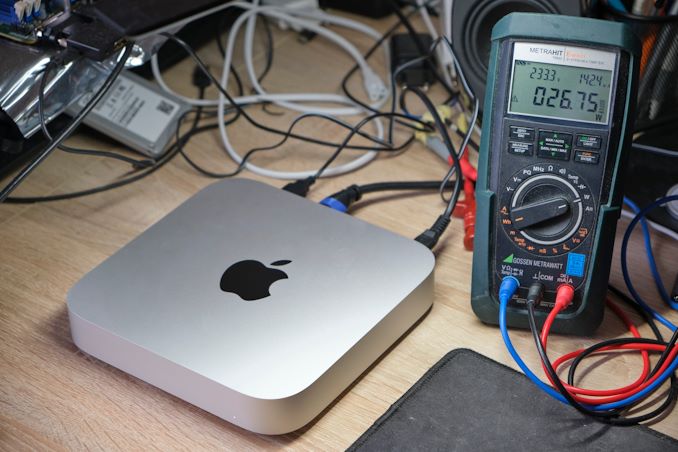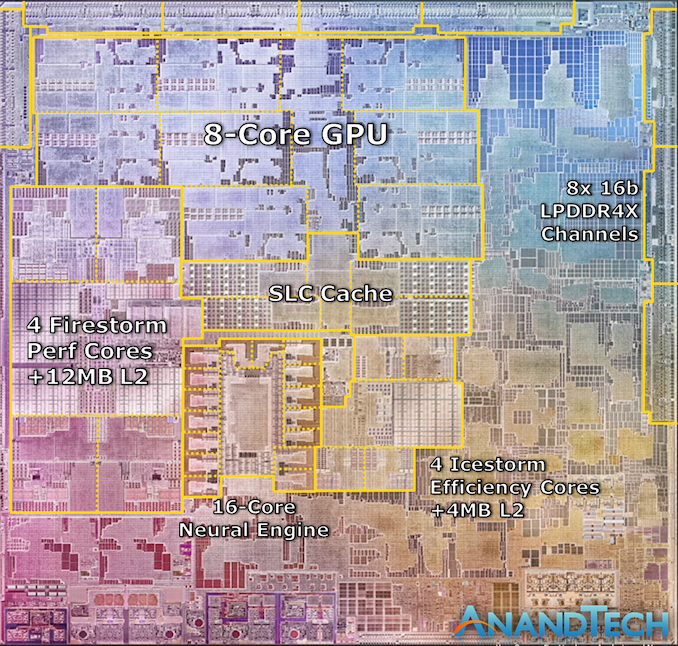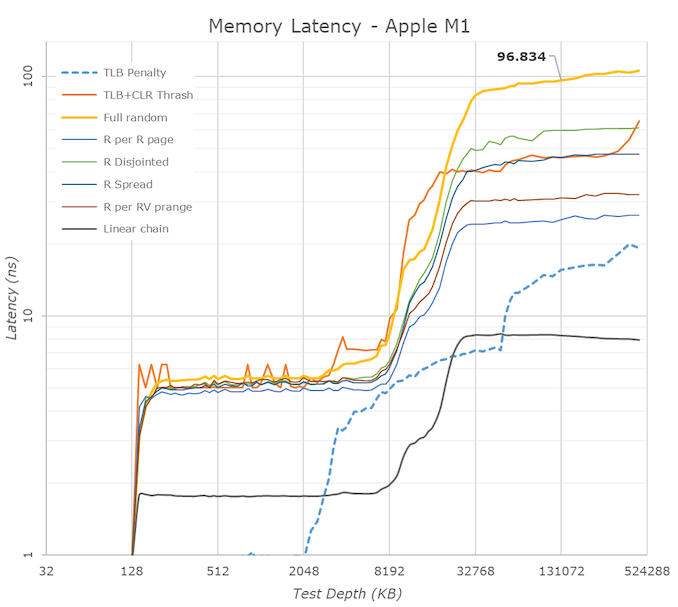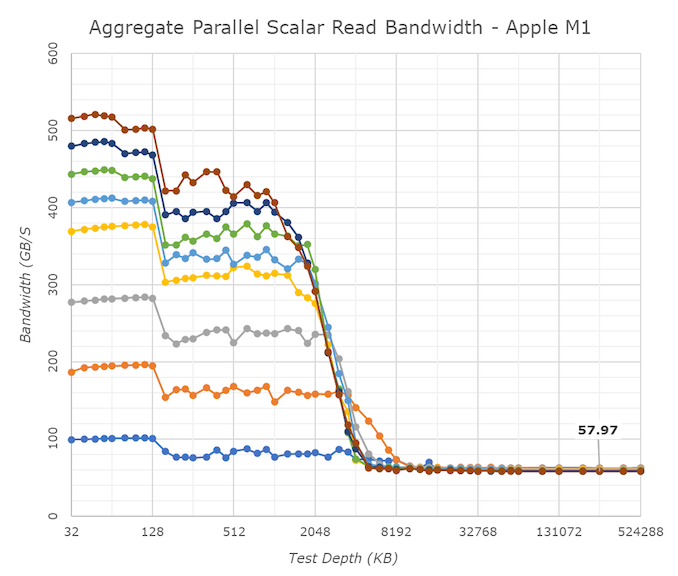The 2020 Mac Mini Unleashed: Putting Apple Silicon M1 To The Test
by Andrei Frumusanu on November 17, 2020 9:00 AM EST
Last week, Apple made industry news by announcing new Mac products based upon the company’s new Apple Silicon M1 SoC chip, marking the first move of a planned 2-year roadmap to transition over from Intel-based x86 CPUs to the company’s own in-house designed microprocessors running on the Arm instruction set.
During the launch we had prepared an extensive article based on the company’s already related Apple A14 chip, found in the new generation iPhone 12 phones. This includes a rather extensive microarchitectural deep-dive into Apple’s new Firestorm cores which power both the A14 as well as the new Apple Silicon M1, I would recommend a read if you haven’t had the opportunity yet:
Since a few days, we’ve been able to get our hands on one of the first Apple Silicon M1 devices: the new Mac mini 2020 edition. While in our analysis article last week we had based our numbers on the A14, this time around we’ve measured the real performance on the actual new higher-power design. We haven’t had much time, but we’ll be bringing you the key datapoints relevant to the new Apple Silicon M1.
Apple Silicon M1: Firestorm cores at 3.2GHz & ~20-24W TDP?
During the launch event, one thing that was in Apple fashion typically missing from the presentation were actual details on the clock frequencies of the design, as well as its TDP which it can sustain at maximum performance.
We can confirm that in single-threaded workloads, Apple’s Firestorm cores now clock in at 3.2GHz, a 6.66% increase over the 3GHz frequency of the Apple A14. As long as there's thermal headroom, this clock also applies to all-core loads, with in addition to 4x 3.2GHz performance cores also seeing 4x Thunder efficiency cores at 2064MHz, also quite a lot higher than 1823MHz on the A14.
Alongside the four performance Firestorm cores, the M1 also includes four Icestorm cores which are aimed for low idle power and increased power efficiency for battery-powered operation. Both the 4 performance cores and 4 efficiency cores can be active in tandem, meaning that this is an 8-core SoC, although performance throughput across all the cores isn’t identical.
The biggest question during the announcement event was the power consumption of these designs. Apple had presented several charts including performance and power axes, however we lacked comparison data as to come to any proper conclusion.
As we had access to the Mac mini rather than a Macbook, it meant that power measurement was rather simple on the device as we can just hook up a meter to the AC input of the device. It’s to be noted with a huge disclaimer that because we are measuring AC wall power here, the power figures aren’t directly comparable to that of battery-powered devices, as the Mac mini’s power supply will incur a efficiency loss greater than that of other mobile SoCs, as well as TDP figures contemporary vendors such as Intel or AMD publish.
It’s especially important to keep in mind that the figure of what we usually recall as TDP in processors is actually only a subset of the figures presented here, as beyond just the SoC we’re also measuring DRAM and voltage regulation overhead, something which is not included in TDP figures nor your typical package power readout on a laptop.

Starting off with an idle Mac mini in its default state while sitting idle when powered on, while connected via HDMI to a 2560p144 monitor, Wi-Fi 6 and a mouse and keyboard, we’re seeing total device power at 4.2W. Given that we’re measuring AC power into the device which can be quite inefficient at low loads, this makes quite a lot of sense and represents an excellent figure.
This idle figure also serves as a baseline for following measurements where we calculate “active power”, meaning our usual methodology of taking total power measured and subtracting the idle power.
During average single-threaded workloads on the 3.2GHz Firestorm cores, such as GCC code compilation, we’re seeing device power go up to 10.5W with active power at around 6.3W. The active power figure is very much in line with what we would expect from a higher-clocked Firestorm core, and is extremely promising for Apple and the M1.
In workloads which are more DRAM heavy and thus incur a larger power penalty on the LPDDR4X-class 128-bit 16GB of DRAM on the Mac mini, we’re seeing active power go up to 10.5W. Already with these figures the new M1 is might impressive and showcases less than a third of the power of a high-end Intel mobile CPU.
In multi-threaded scenarios, power highly depends on the workload. In memory-heavy workloads where the CPU utilisation isn’t as high, we’re seeing 18W active power, going up to around 22W in average workloads, and peaking around 27W in compute heavy workloads. These figures are generally what you’d like to compare to “TDPs” of other platforms, although again to get an apples-to-apples comparison you’d need to further subtract some of the overhead as measured on the Mac mini here – my best guess would be a 20 to 24W range.
Finally, on the part of the GPU, we’re seeing a lower power consumption figure of 17.3W in GFXBench Aztec High. This would contain a larger amount of DRAM power, so the power consumption of Apple’s GPU is definitely extremely low-power, and far less than the peak power that the CPUs can draw.
Memory Differences
Besides the additional cores on the part of the CPUs and GPU, one main performance factor of the M1 that differs from the A14 is the fact that’s it’s running on a 128-bit memory bus rather than the mobile 64-bit bus. Across 8x 16-bit memory channels and at LPDDR4X-4266-class memory, this means the M1 hits a peak of 68.25GB/s memory bandwidth.
In terms of memory latency, we’re seeing a (rather expected) reduction compared to the A14, measuring 96ns at 128MB full random test depth, compared to 102ns on the A14.
Of further note is the 12MB L2 cache of the performance cores, although here it seems that Apple continues to do some partitioning as to how much as single core can use as we’re still seeing some latency uptick after 8MB.
The M1 also contains a large SLC cache which should be accessible by all IP blocks on the chip. We’re not exactly certain, but the test results do behave a lot like on the A14 and thus we assume this is a similar 16MB chunk of cache on the SoC, as some access patterns extend beyond that of the A14, which makes sense given the larger L2.
One aspect we’ve never really had the opportunity to test is exactly how good Apple’s cores are in terms of memory bandwidth. Inside of the M1, the results are ground-breaking: A single Firestorm achieves memory reads up to around 58GB/s, with memory writes coming in at 33-36GB/s. Most importantly, memory copies land in at 60 to 62GB/s depending if you’re using scalar or vector instructions. The fact that a single Firestorm core can almost saturate the memory controllers is astounding and something we’ve never seen in a design before.
Because one core is able to make use of almost the whole memory bandwidth, having multiple cores access things at the same time don’t actually increase the system bandwidth, but actually due to congestion lower the effective achieved aggregate bandwidth. Nevertheless, this 59GB/s peak bandwidth of one core is essentially also the speed at which memory copies happen, no matter the amount of active cores in the system, again, a great feat for Apple.
Beyond the clock speed increase, L2 increase, this memory boost is also very likely to help the M1 differentiate its performance beyond that of the A14, and offer up though competition against the x86 incumbents.
- Page 1: Apple Silicon M1: Recap, Power Consumption
- Page 2: Benchmarks: Whatever Is Available
- Page 3: M1 GPU Performance: Integrated King, Discrete Rival
- Page 4: SPEC2006 & 2017: Industry Standard - ST Performance
- Page 5: SPEC2017 - Multi-Core Performance
- Page 6: Rosetta2: x86-64 Translation Performance
- Page 7: Conclusion & First Impressions













682 Comments
View All Comments
tkSteveFOX - Friday, November 20, 2020 - link
Just imagine if they up the TDP to 40W on the next 3nm process next year?Perhaps the CPU part won't get big gains (let's face it, CPU is better than anything on the market up to 60W), but GPU should double the performance. By that time 95% of apps will be native as well, so M1 performance will gain another 10-20% additional performance in all scenarios.
mdriftmeyer - Saturday, November 21, 2020 - link
GPU double performance. That's delusional right there. Nothing in Apple's licensed IP will ever touch AMD GPU performance moving forward. Your claim the CPU is better than anything on the market up to 60W is also delusional.Enjoy 2021 when very little changes inside the M Series but AMD keeps moving forward. Being a NeXT/Apple alum I was hoping my former colleagues were wiser and moved to AMD three years ago and pushed back this ARM jump two more years.
ARM has reached its zenith in designs in the embedded space and that is the reason everything wowed is about Camera Lenses. Fab processes are reaching their zenith as well.
M1 is 12 years of ARM development by Apple's teams after buying PA Semi in 2008. It took 12 years with unlimited budgets to produce the M1. It's far less impressive than people realize.
Most of Apple's frameworks are already fully optimized after the past 8 years of in-house development. People keep thinking this code base is young. It's not. It's mature. We never released anything young back at NeXT or Apple Engineering. That hasn't change since I left. It's the mantra from day 1.
The architecture teams at AMD have decades more experience in CPU designs and nothing released here is something they haven't already worked on in-house.
Intel's arrogance is one of the greatest falls from the top in computing history. And it's only going to get worse for the next five years.
dontlistentome - Saturday, November 21, 2020 - link
Not sure when Intel will learn - they let the Gigahertz marketeers ruin them last time AMD had a lead, and this time it was the accountants. Wondering who screws them up again 15 years from now?corinthos - Monday, November 23, 2020 - link
Intel made so many mistakes and brought in outsiders who just didn't have the goods to set it on a good path forward. The board members who chose these folks are partially to blame. Larrabee was just one of the earlier warning signs.corinthos - Monday, November 23, 2020 - link
So are you saying that there's more limited growth opportunity for Apple going down the ARM path than people realize, and that the prospect of AMD producing competitive/superior low-powered processors is going to be much better?For now, it seems that for the power consumed, the M1 products have a leg up in power-performance over Intel or AMD-based competing products. Can Apple take that and scale it upwards to be competitive or even a leader in the desktop space?
I think about how there are some test results coming in already showing how a 2019 Mac Pro with a 10-core cpu and expensive discrete amd gpu and loads of ram being outshined by these M1's in some video editing workloads and wonder if a powerhouse desktop is such a good investment these days. That thing came out like a year ago and cost probably around $10K.
Focher - Tuesday, November 24, 2020 - link
From your post, I suspect you are not going to enjoy the next 2 years. Saying things like the code is already fully optimized is so ridiculous on its face, it’s hard to believe someone wrote it. If time led to full optimization, then what’s the magic time horizon where that happens? If you think Apple just played its full hand with the M1, you’ve never paid attention to Apple.blackcrayon - Tuesday, November 24, 2020 - link
I would think doubling GPU performance would be one of the easier updates they could make. More cores, more transistors with their existing design - the same thing they've done year after year to make "X" versions of their iPhone chips for the iPad. The M1 isn't at the point where doubling the GPU cores would make it gigantic and unsuitable for a higher end laptop or desktop. Unless you thought he meant "double Nvidia's best performance" or something which isn't going to be possible currently :)zodiacfml - Friday, November 20, 2020 - link
Coming back here just to leave a comment though the M1 truly leaves any previous Apple x86 product in the dust, it is far from the performance of a Ryzen 4800U which has TDP of 15W. The M1 is at 5nm while consuming 20-24W.The M1 iGPU is mighty though, which can only be equaled or beaten by next year/generation APU or Intel iGPU
thunng8 - Saturday, November 21, 2020 - link
The 4800u uses up to 50w running benchmarks and under load. You will never see a current gen Ryzen without active cooling. In laptops running benchmarks, the fans ramps up to 6000rpm while the m1 can run in the MacBook Air with no cooling with hardly any performance degradation. And there’s also the issue of battery life where the m1 laptop with a smaller battery can far outlast any Ryzen laptop.In short you cannot compare intel and AMDs dubious tdp numbers with the number measured for the m1.
BushLin - Saturday, November 21, 2020 - link
M1 and 4800U (in 15W mode) are consuming similar 22-24W power when the 4800U is showing better Cinebench performance, no denying the single thread advantage of the M1 though.If you've seen a 4800U anywhere near 50W, it won't have been in its 15W mode and running an unrealistic test like Prime95.
Just the facts Jack.